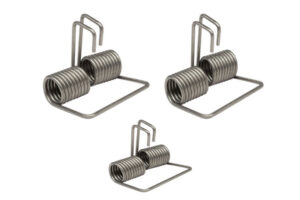Torsion Spring Customization

Torsion springs are vital components in various industries, providing rotational force and storing mechanical energy. They offer precise control and are widely used in applications ranging from automotive to aerospace, robotics to manufacturing equipment. However, to achieve optimal performance, it is often necessary to customize torsion springs to meet specific requirements of customer’s new projects.
As a professional maker in China,we always get inquiry from oversea customers about the custom-made torsion springs.
What is torsion spring
Torsion springs are helical springs designed to resist torque forces by exerting rotational energy. They consist of tightly wound coils that generate torque when twisted, thus providing rotational force. The design parameters such as wire diameter, coil diameter, and number of coils define the strength, flexibility, and torque characteristics of a torsion spring. Customizing these parameters enables tailoring the spring’s performance to suit precise application needs.
How to design custom torsion spring
Each application has its own set of requirements that demand specific torsion spring characteristics. Customization allows manufacturers to make these unique needs effectively. Some common customization factors include:
a) Torque Requirements: The torque required to perform a particular function may differ significantly among applications. By customizing the geometry and material selection, torsion springs can be designed to deliver the exact torque needed, ensuring optimal functionality.
b) Space Constraints: Limited space within an application may necessitate the customization of torsion springs to meet dimensional restrictions. Custom designs can optimize the space utilization while maintaining the required torque and load-bearing capacity.
c) Environmental Factors: Different environments, such as extreme temperatures, corrosive atmospheres, or high vibration levels, can impact the performance of torsion springs. Customized solutions can incorporate appropriate materials and surface treatments to enhance durability and resistance to environmental factors.
Material Selection:
Choosing the right material is paramount in torsion spring customization. Factors such as tensile strength, corrosion resistance, fatigue life, and temperature range must be considered when selecting the material. Commonly used materials include
- stainless steel,
- carbon steel,
- alloy steel,
- and non-ferrous alloys like phosphor bronze.
Wire diameter:0.1mm- 12mm
Surface Treament:Black oxide,Zinc/Nicke/Chrome plating,power coating,oiled to prevent rust,passivate,etc.
By understanding the application’s operating conditions and performance requirements, manufacturers can recommend or develop materials that best suit the specific needs.
Manufacturing Processes:
Customization often involves unique manufacturing processes to achieve desired spring characteristics. Specialized techniques like hot winding, cold setting, shot peening, or stress relieving can be used to enhance the spring’s performance, durability, and lifespan. Manufacturers may also utilize advanced computer-aided design (CAD) software and simulation tools to evaluate the customized design’s performance prior to production.
Get a quote
If you need any Torsion Spring Customization , from small or big, any material and size, Please contact us for more details. We can quote you within 24 hours based on drawing or samples.






